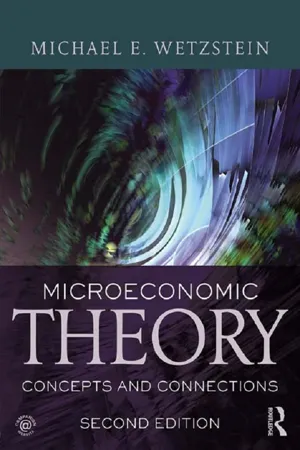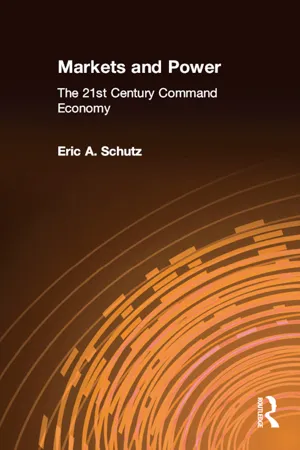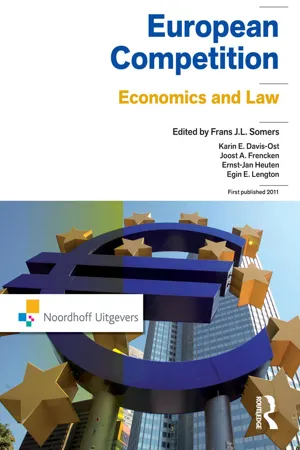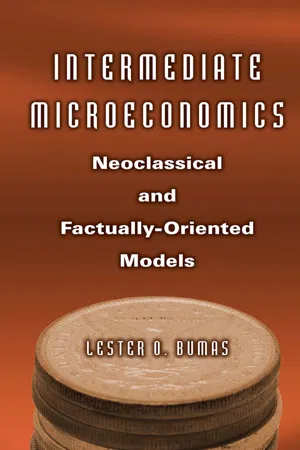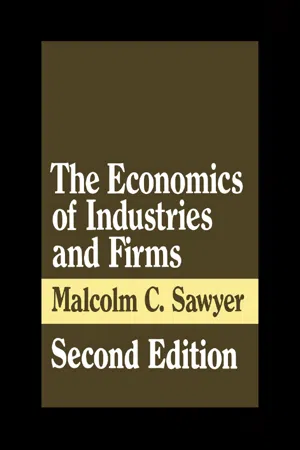Economics
Monopoly Power
Monopoly power refers to the ability of a single company to dominate a particular market, giving it significant control over prices and supply. This can lead to reduced competition, higher prices for consumers, and potentially lower quality products or services. Monopoly power can also stifle innovation and limit consumer choice.
Written by Perlego with AI-assistance
Related key terms
10 Key excerpts on "Monopoly Power"
- eBook - ePub
Microeconomic Theory second edition
Concepts and Connections
- Michael E. Wetzstein(Author)
- 2013(Publication Date)
- Routledge(Publisher)
13 , we consider the market structure of monopoly behavior. Monopoly is the polar case to perfect competition. In a monopoly market, there is a single firm producing a product for which there are no close substitutes. The firm is the industry and thus faces the market demand curve for its price and output decisions. Given the downward-sloping market demand curve, the monopoly has control over the price it receives for its output. For example, if the monopoly reduced its output, the price per unit it would receive for its output would increase.Monopolies do exist in reality; for example, within a local community, electric, gas,and water companies are generally each a monopoly. Firms with few close substitutes— such as an athletic association offering tickets to a major sporting event, an ice-cream stand on a beach, and a gasoline station on a remote road—can also behave like monopolies. Such firms are said to have some degree of Monopoly Power, defined as the ability to set price above marginal cost. The degree of Monopoly Power depends on the ability of a firm to profitably set its price above the perfectly competitive price. The fewer the number of close substitutes, the closer a firm is to being a true monopoly. Thus, for a monopoly, the demand for the product must be reasonably independent of the price of other products. Specifically, the cross-price elasticity of demandwhich measures the relative responsiveness in the demand for the monopoly product j to changes in the price of commodity i , must bewhere α is some arbitrarily small positive number.Monopoly Power. A firm's ability to set price above marginal cost. E.g., a winery's ability to set a price for its award-wining wine above the marginal cost of production.Application: Monopoly Power and the United States Post OfficeOnly the Post Office is allowed to deliver first-class mail, resulting in a monopoly in existence since the founding of the country. The Post Office has always insisted that it requires this protection for maintaining a national service that reaches every American at the same price. However, this Post Office monopoly on delivering letters will likely fade away. The former Postmaster General Marvin Runyon anticipates a world, by 2020, in which paper mail and electronic mail blend together and the Postal Service is a much more automated operation.Through the natural forces of the marketplace, the Monopoly Power of the Post Office will vanish. By the year 2020, there will be so many ways to communicate, advertise, and ship merchandise that the Monopoly Power of the Post Office will vanish due to natural market forces. Already, electronic mail is a major factor in communications. For example, it costs over 50 cents to deliver a Social Security check by “snail mail” and just 2 cents electronically.The economics are just too compelling not to drive a change. By 2020, it is likely that millions of Americans will be working at home in virtual companies and small home-based businesses. The Postal Service will have to support this working environment by providing the full array of postal services electronically. However, United Parcel Service, Federal Express, and other carriers will be offering these same or similar services. - eBook - ePub
Markets and Power
The 21st Century Command Economy
- Eric A. Schutz(Author)
- 2016(Publication Date)
- Routledge(Publisher)
In principle a monopoly may also use its power to exploit by means of a more explicit command over people as well, that is, by means of specific commands or instructions given to customers that the latter must obey if they are to have access to the monopoly’s commodity. Competitive retailers of a monopolist’s product, for example, may be compelled to package or display the product not as they choose but as the monopolist chooses; wholesalers may even be restricted in whom they may sell the monopolist’s product to. Firms taking what amounts to a managerial role in other firms with which they do business may be even more common in cases of monopsony, where, for example, a firm may even place some of its own managers in a position of overseeing the daily operations of subordinate parts or materials suppliers (I will discuss such cases further in the next chapter). Just how important is this kind of power structure in reality? The basic model of monopoly holds a solid place in traditional economic theory from Adam Smith onward, but its bearing upon the real world has been subjected to an especially heated criticism from the recently ascendent right-wing of mainstream economics. One important concern raised in that criticism is that monopoly per se is rare in reality: aside from the rest of what appear to be quite competitive industries, the only markets that are even close to being monopolistic are cases either of oligopoly or of a dominant firm among other competing smaller firms. In both such cases, firms are arguably involved in competitive situations with other firms, and few opportunities for exercising power can exist: If any one firm attempts to exert Monopoly Power, customers may take their business to other firms - eBook - ePub
- Andrew Barkley, Paul W. Barkley(Authors)
- 2016(Publication Date)
- Routledge(Publisher)
Market Power .Market power is the ability of a firm to set the price of a good higher than the cost of production. A firm with market power can influence the price of its product, or the competitive market price.- Market Structure = the organization of an industry, typically defined by the number of firms in an industry.
- Market Power = the ability to affect the price of output. A firm with market power faces a downward-sloping demand curve for its product.
When there are numerous firms in an industry, price competition forces each firm to charge the competitive market price, P = MC. If a competitive firm raises the price of the good it produces, it will sell nothing because its customers shift their purchases to other firms which are selling the same product at the lower competitive price.When there are only a few firms in an industry, individual firms may be able to charge a price higher than the competitive price, forcing consumers to pay more than the product’s cost of production. Since this outcome is inefficient, the US government has legislated against the blatant use of market power. In 1890, the United States passed the Sherman Antitrust Act (1890) to protect consumers from firms that used excessive amounts of market power to influence the prices charged for their products. Giant firms like Standard Oil and the American Tobacco Company were among the first to be regulated by the antitrust laws. Why? Because they used their immense market power to set prices of their products at a level above the cost of production. They, and others, made huge profits from their price-setting activities. Since these practices placed a heavy burden on individual consumers and other sectors of the economy, the government took steps to limit the price-setting abilities of monopolistic firms. - eBook - ePub
- Andrew Barkley, Paul W. Barkley(Authors)
- 2020(Publication Date)
- Routledge(Publisher)
market power .Market power is the ability of a firm to set the price of a good higher than the cost of production. A firm with market power can influence the price of its product, or the competitive market price.- • Market Power = the ability to affect the price of output. A firm with market power faces a downward-sloping demand curve for its product.
When there are numerous firms in an industry, price competition forces each firm to charge the competitive market price, P = MC. If a competitive firm raises the price of the good it produces, it will sell nothing because its customers shift their purchases to other firms that are selling the same product at the lower competitive price.When there are only a few firms in an industry, individual firms may be able to charge a price higher than the competitive price, forcing consumers to pay more than the product’s cost of production. Since this outcome is inefficient, the US government has legislated against the blatant use of market power. In 1890, the United States passed the Sherman Antitrust Act (1890) to protect consumers from firms that used excessive amounts of market power to influence the prices charged for their products. Giant firms like Standard Oil and the American Tobacco Company were among the first to be regulated by the antitrust laws. Why? Because they used their immense market power to set prices of their products at a level above the cost of production. They, and others, made huge profits from their price-setting activities. Since these practices placed a heavy burden on individual consumers and other sectors of the economy, the government took steps to limit the price-setting abilities of monopolistic firms. - eBook - ePub
- F.J.L. Somers, K.E. Davis-Ost, J.E. Frencken, E. Heuten(Authors)
- 2019(Publication Date)
- Routledge(Publisher)
Finally, a company may contribute to reducing the interchangeability of products and standardisation. As a result of this, customers will be ‘forced’ to choose an established supplier when making a new purchase. This issue played a part in the case referred to at the beginning of this chapter, in which Microsoft refused to make data public that other suppliers needed to have their software link up with the Windows operating system. Another example in this context is ink cartridges for printers: the owner of a specific printer has only a limited choice of cartridges (which are suitable for only one brand or even printer type), and he will pay a relatively high price for these.2.2 Use and abuse of market dominance
In the European Union (but also outside it, e.g. in the United States) having market dominance is not forbidden. In many cases a company acquires market dominance because it performs better (low price, high quality) than its competitors; as a result it creates more loyal customers. It becomes a different story when this company abuses its power. In that case we see unilateral (uncoordinated, see also chapter 3 ) behaviour: the dominant company pushes a competitor, customer or supplier into a disadvantaged position, in some cases eventually – after all competitors have disappeared from the market – creating a monopoly. The abuse may consist of asking excessively high prices or relate to the behaviour of the company: limiting existing and potential competition as much as possible (exclusionary practices) in order to maintain its dominance.The following are the principal ways in which companies may abuse their power:Excessive prices
In chapter 1 (section 1.2.1) we defined market power as the extent to which a company is able to set its prices higher than its marginal costs. It was shown in chapter 1 that in the case of perfect competition the price level will fall to the level of the average total costs. As long as prices are higher, there are supernormal profits, which encourage entry into the market. This leads to more supply in the market and, consequently, to lower prices.In the case of a monopoly, this process will not take place – see the graph below (Figure 2.6 ):FIGURE 2.6 Maximum profit in MonopolyAs discussed in chapter 1 (case study 1.2), a company will achieve maximum profit in the situation that MR = MC. In a monopoly situation (in contrast to a situation of perfect competition) the demand line for individual companies is a descending one (see, for example, figure 1.3 - eBook - ePub
European Union Law
Volume II: Towards a European Polity?
- Damian Chalmers, Erika Szyszczak(Authors)
- 2018(Publication Date)
- Routledge(Publisher)
126. An undertaking's economic strength is not measured by its profitability; a reduced profit margin or even losses for a time are not incompatible with a dominant position, just as large profits may be compatible with a situation where there is effective competition.127. The fact that UBC's profitability is for a time moderate or non-existent must be considered in the light of the whole of its operations.128. The finding that, whatever losses UBC may make, the customers continue to buy more goods from UBC which is the dearest vendor, is more significant and this fact is a particular feature of the dominant position and its verification is determinative in this case.129. The cumulative effect of all the advantages enjoyed by UBC thus ensures that is has a dominant position on the relevant market.The difficulty with establishing market power is, as Landes and Posner have put it, that the fact of market power must be distinguished from the amount of market power.15 There may be times where a firm will be able to increase its price above that which is competitive, yet intervention is unnecessary as this represents no more than a blip in what is usually a competitive market. For an undertaking to have sufficient market power to justify intervention, it must be shown that it has had that power over a sufficient period of time.16Baden Fuller, C. ‘Article 86 EEC: Economic Analysis of the Existence of a Dominant Position’ (1979) 4 European Law Review 423, 436-437
Economists have noted that few monopolies other than those prescribed by law have lasted more than decade or two, as even without anti-monopoly laws, the process of competition is very powerful. But those applying the EEC Treaty may have (rightly or wrongly) shorter time horizons. Marshall[17 - eBook - ePub
- Bonnie Nguyen, Andrew Wait(Authors)
- 2015(Publication Date)
- Routledge(Publisher)
13 MonopolyDOI: 10.4324/9781315690339-1313.1 Introduction
In the last chapter, we looked at a market that exhibited the most extreme characteristics of competition. Now we turn to the other end of the spectrum: here we examine markets with only one seller. A market with one seller is a monopoly, and that seller is a monopolist. In this chapter, we will examine how the market power of a monopolist allows it to charge higher prices in order to increase its profits, and we consider the welfare implications of this market power. We then analyse how the monopolist might use price discrimination to further increase its profits. Finally, we look at the regulation of a natural monopoly, where it is less costly for the whole market to be serviced by one firm, rather than two or more.13.2 Characteristics of a monopoly
Monopolies have the following characteristics:- One seller and many buyers. There is a single producer of all output in the market.
- Price maker. Because the monopolist is the only firm in the market, it has the market power to determine the price in the market – that is, it is a price maker.
- Barriers to entry. Firms that might like to enter the market are prevented from doing so by barriers to entry. Barriers to entry may exist for a number of reasons: the monopolist may have access to a natural resource or technology that is not available to other firms; the monopolist might hold a patent or a copyright that prevents other firms from selling the same product; the government might ban entry by other potential seller; or, the monopolist might simply have a lower cost of production that effectively allows them to prevent other firms from entering the market.
13.3 The single-price monopolist
In this section, we examine the behaviour of a monopolist who charges the same price to all of its consumers (also known as a single-price monopolist).Because the monopolist is the sole producer, it faces all the demand in the market. In other words, the monopolist faces the downward-sloping market demand curve. However, the monopolist does not itself have a supply curve; recall from Chapter 8 that the supply curve applies only to competitive firms, as a supply curve is derived assuming a firm is a price taker.1 - eBook - ePub
Intermediate Microeconomics: Neoclassical and Factually-oriented Models
Neoclassical and Factually-oriented Models
- Lester O. Bumas(Author)
- 2015(Publication Date)
- Routledge(Publisher)
CHAPTER EIGHTMonopolyThe word monopoly wrongly seems to be the briefest of contradictions with mono meaning one and poly meaning many. In fact though, monopoly is a corruption of the Greek words monos polein , which can be translated as one seller. The one-seller monopoly faces a negative-sloping demand function, that of the entire market. This allows it to set the price of its product. But almost all of our gross domestic product is produced by firms which face negative-sloping demand functions and their market structure is monopolistic . The stress of this chapter is on monopolies, but I sometimes stray to include firms which are monopolistic.The Characteristics of a Monopoly Market
The following characteristics of a monopoly market warrant examination: The market has one seller and many buyers. Entry into and exit out of the market are disallowed. The product of the monopoly is standardized and there are no close substitutes. Price is set by the monopoly. There may be a single price for the product or there may be price discrimination with one set of buyers (e.g., “residential”) charged one price and a different set, for example, “business,” charged another. The rate of production is essentially set by buyers who determine how much they wish to purchase at the monopoly-set price. Under monopoly there is no unique relationship between price and the rate of production and, as a result, no theoretical supply function exists.There are two kinds of monopolies: natural and unnatural. The former owes its existence to production which exhibits increasing returns to scale, the latter to institutional power.Figure 8.1. The Long-Run Planning Function and Expected DemandNatural Monopolies
Natural monopolies can be defined as follows:Natural Monopolies - eBook - ePub
- Thomas J. Miceli(Author)
- 2017(Publication Date)
- Stanford Economics and Finance(Publisher)
The literature on antitrust is vast, so this chapter offers only an overview of some of the key issues, with an emphasis on the insights economic theory can offer. We begin with a review of the economics of perfect competition, which provides a benchmark for measuring the efficiency losses due to monopoly. We then turn to the role of the law in promoting competition.1 Perfect Competition Versus MonopolyA monopoly is defined to be a market that is served by a single seller. The problem of monopoly, and the economic justification for legal intervention to prevent it, is that monopolistic firms set a price and output level that are inefficient, resulting in a loss of welfare. The nature of this loss is best seen in relation to a perfectly competitive market, which, because it allocates resources efficiently, maximizes social welfare.1.1 Competitive Markets and WelfareThe defining characteristic of a competitive market is the large number of firms, which makes it impossible for any one firm to affect the market price. For this reason, we say that firms are price takers . Figure 10.1 illustrates the determination of equilibrium price and quantity in a competitive market. The left panel shows the market output and price, which is determined by the intersection of the supply and demand curves. At this point, the amount of the good that consumers want to buy at the market price exactly equals the aggregate amount that producers supply to the market. The right panel of Figure 10.1 shows the corresponding output of an individual firm, q *, which occurs where the equilibrium price of the good (the firm’s marginal revenue, which it takes as given), equals its marginal cost, or where P * = MC .1The outcome depicted in Figure 10.1 - eBook - ePub
- Malcolm Sawyer(Author)
- 1985(Publication Date)
- Routledge(Publisher)
There is the major question of whether the economy can be regarded as perfectly competitive or not. One group, particularly associated with the Chicago school, argue that most of the economy is competitive, and that most if not all of monopoly persists only with the active support of government. For example, Stigler (1949) says that for the American economy ‘it is my present judgement that competition declined moderately from the Civil War to the end of the nineteenth century, and thereafter increased’. He estimates that 81 per cent of the American economy is competitive and 19 per cent monopolistic, a view which clearly places industries at either the competitive or monopolistic ends of the structure spectrum, with no reference to intermediate cases of oligopoly. Friedman (1962) argues that ‘probably the most important source of Monopoly Power has been government assistance, direct or indirect’.This view would indicate that industrial concentration would be expected to be fairly low and to exhibit no upward trend over time. Barriers to entry into an industry would generally be expected to be low with government activity seen as a major cause of most substantial entry barriers. The virtual absence of barriers to entry into an industry leads to prices pushed toward the level of average costs, and removes any monopoly profits.An alternative view is that whilst perfect competition has desirable properties atomistic competition is absent from a substantial number of industries, and that government policy should be geared towards moving those industries in the competitive direction. This type of policy is often labelled a non-discretionary or anti-trust. Such a policy would involve the break-up of existing situations of monopoly and oligopoly, and the prevention of mergers which would lead to oligopolies, and the prevention of mergers leading to the formation of further oligopolies.
Learn about this page
Index pages curate the most relevant extracts from our library of academic textbooks. They’ve been created using an in-house natural language model (NLM), each adding context and meaning to key research topics.
